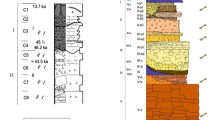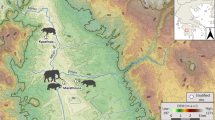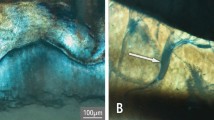Key Points
-
The TE9 fossil (1.2 million years old) is the oldest human fossil to have been found in Europe.
-
This paper presents macroscopic analysis of dental and bone lesions of the specimen.
-
There is gross evidence in the specimen of dental injuries and vertical bone loss.
Abstract
Atapuerca, in the north of Spain, is the archaeological site where the oldest hominid remains within Europe have been found. In 2008 a jaw fragment, corresponding to the symphyseal area, was discovered in the area called the 'Elephant's pit'. Its age has been estimated at 1.2 million years and it is considered to be the oldest human fossil found in Europe and is from the lower Pleistocene. This work analyses the dental and skeletal damage to the specimen, detected in a macroscopic study of possible horizontal and vertical bone loss at the level of support of the remaining teeth. The limited presence of dental scale, the pattern of destruction and the decreased bone density due to increased marrow spaces suggest the presence of possible periodontal disease.
Similar content being viewed by others
Introduction
The Atapuerca mountains (Burgos, Spain), declared a world heritage site by the UNESCO, encompass a set of archaeological sites of great paleoanthropological value. The Atapuerca discovery was the result of serendipity, owing to a large railway construction trench that exposed the area.
In the late nineteenth century, a time of boom in the Basque steel mills, British businessman Richard Preece Williams decided to build a railway to transport coal and iron ore from the Demanda mountain chain to the junction with the railway from Burgos to Bilbao.
It was precisely this railway construction work that exposed the paleoanthropological sites in question. The railway cutting revealed all the constituent layers of the deposit and made it possible to visualise the archaeological material inside the cut levels. These deposits of rock and clay contained bones and stone tools, particularly in the two caves known as the Gallery and the Gran Dolina; but nearly eight decades were to pass before they were excavated by scientists.
Until that time, the most famous deposits were the Gran Dolina and the Sima de los Huesos, a site which has provided the greatest number of human fossil bones worldwide. To date, more than 4,000 fossils of a new species, named Homo antecessor, have been recovered.1
Close to the Gran Dolina and the Sima de los Huesos caves, the Trinchera del Elefante (TE) can be located, where the oldest hominid remains found in Europe to date were discovered. Among the human remains retrieved, the jaw fragments and skulls are almost complete. According to paleomagnetism data, they are very old (between 300,000 and 1,200,000 years) and belong to the Pleistocene epoch, which ranges from 1,800,000 years ago to approximately 9,000 BC.2,3
The latest fossil discovered was retrieved in 2008 and is a fragment corresponding to the symphysis area of a mandible (Fig. 1). It preserves several teeth and is known by the acronym TE9 (Trinchera Elefante, Level 9: excavation deep level), and is considered to be the oldest human fossil to have been found in Europe with an age of 1,200,000 years or thereabouts (see Table 1).4,5 Given these considerations, this specimen is considered highly protected material by the National Research Centre of Human Evolution (CENIEH) and thus strong measures have been imposed to restrict access to it.
Possibly due to its recent discovery, the age of the specimen under study at the time of death has not yet been determined, even though there are methods available for doing so.6,7
TE9 mandibular fossil remains
The piece is a fragment of mandible corresponding to the area of the symphysis and mandible body on both sides, with a series of teeth and the sockets of the central incisors empty. Both mental foramina are visible and numerous anterior foramina in the symphyseal level can be observed. There are no ascending branches.
In order to analyse the degree of dental attrition-abrasion, we followed the criteria established by Lovejoy in 1985. Lovejoy described the level of attrition in a population of hunters from archaeological excavations of the Libben site.8 The Lovejoy criteria provide a forensic dentistry method for the determination of age following the pattern of occlusal abrasion.
Considering the heavy restrictions placed on access to the specimen, the CEJ (cemento-enamel junction), measuring bone defects with rule proportionate to the actual dimensions of the specimen, was considered as a reference point to determine the height of the alveolar bone present. This provided an idea of the periodontal condition of the specimen studied. Upon evaluating the degree of periodontitis, we used the criteria of Gustafson.9 These criteria provide a forensic dentistry method for determining age using six items rated on a scale of one to three:
-
Attrition
-
Periodontitis
-
Secondary dentin
-
Cement apposition
-
Root resorption
-
Transparency.
In this study we used the second item.
Paleopathological findings
The strong degree of dental attrition on the incisors and canines of individuals from the Sima de los Huesos site is a result of the combination of the normal function of these teeth (food processing before ingestion) and non-chewing tasks ('stuff and cut').10
It was possible to distinguish the features of attrition occurring in life from those affecting dental crowns after the individual's death.10
Teeth present and dental damage
On the right side, the lateral incisor and canine and root remains of the first and second premolars are present, while on the left side the root of the lateral incisor, the canine, and the first and second premolars are preserved.
The right canine exhibits a strong degree of attrition-abrasion-erosion (Grade F, Lovejoy) both on the incisal and vestibular face, which reveals part of the pulp chamber of the tooth.
The right lateral incisor also has attrition-abrasion damage at incisal level (Grade B2, Lovejoy). In both teeth, especially on the lingual side, there are small deposits of calculus at the cemento-enamel junction.
On the left canine, there is a coronal fracture of the lingual surface that exposes the root canal system and also incisal attrition-abrasion damage (Grade G, Lovejoy).
The second premolar is the tooth best preserved, although strong attrition-abrasion on its face has erased the occlusal masticatory anatomy (Grade G Lovejoy).
No damage from caries is visible on any of the remaining teeth (Fig. 2).
Bone damage
On the right side, the canine shows a generalised loss of periodontal bone support (Fig. 3), more pronounced on the lingual part, with a large circumferential defect of the bone (Grade P3, Gustafson).
The right lateral incisor exhibits a large degree of vertical bone loss (Fig. 2), especially on the buccal wall, although this is not as pronounced as in the canine (Grade P3, Gustafson).
On the left side, at the level of the remaining teeth it is possible to observe a more pronounced vertical bone loss on the buccal side of the canine, with a marked cavitary lesion below the mesial side of this tooth (Grade P3, Gustafson). The surface of the alveolar ridge on the lingual surface shows some bone remodelling11 and has a porous aspect resembling lace (Fig. 3).
Overall, the generalised bone loss, both horizontal and vertical, is severe at the level of alveolar support of the remaining teeth.
On both sides, there are many vascular foramina in an area corresponding to the occlusal two thirds of the mandible body, between the two canines (Fig. 2).
Discussion
The hominids living in the Pleistocene were undoubtedly subject to a good number of pathologies, although owing to the difficulties involved in studying them, the origin, description and consequences of such diseases have not received much attention from the scientific community.11,12,13
Paleopathology studies the diseases of animals and prehistoric humans. This type of research is focused on tissues known to have high mineral contents, such as tooth and bone, which retain their shape and texture over time while soft tissues are rapidly destroyed after death.
Within paleopathology, paleodontopathology studies oral diseases in old human remains.14,15,16 It is therefore a retrospective science.
Properly studied, teeth and their supporting structures can provide a large body of information about the existence of periodontal disease.17,18
In such structures, both dental and paradental, it is possible to find signs of biological disorders, nutritional deficiencies, developmental malformations, diseases and genetic deviations or inflammatory and traumatic processes.19 The study of fossils can define the average age of prehistoric groups, the type of food they ate and some of the illnesses they suffered from, although there is the disadvantage that only one percent of diseases influencing human beings affect the hard tissues. Periodontitis may be due to infectious or mechanical events. In the latter case, an inflammatory component is associated with the occlusal trauma, causing bone resorption, vertically or angularly on the buccal surfaces, as in the case of the specimen analysed here.20
Since Virchow's study in 1915 on bone loss due to periodontal disease in the Ehringsdorf infant jaw,21 there is evidence of periodontal disease in fossil hominids, usually associated with the presence of calculus and severe attrition.22,23,24 Czarnetzki studied vertical bone loss in the Mauer jaw (Germany), with an estimated age of about 700,000 years and belonging to Homo heidelbergensis.25 Ripamonti addressed a specimen from Australopithecus africanus (with an age estimated at 2.5 to 3 million years) showing prepubertal periodontitis, with alveolar bone loss and migration of the deciduous molars.26 Both studies were based on macroscopic analysis.
Similarly, oral diseases have been studied by different specialists, mainly researchers in paleodontopathology, who have found them to be an important source of information.11,27,28,29,30,31 In the specimen addressed here, it is possible to note a moderate presence of calculus arranged pericoronally and apical or coronal to the CEJ. This scant presence of dental calculus, together with a loss of alveolar bone of more than 3 mm, the decrease in bone density, the pattern of destruction, and the increase in medullary spaces suggest the presence of possible periodontal disease.32,33
Conclusion
All these characteristics mean that the piece studied here is unique and a true exception within the odontological literature, not only because it is the oldest specimen in which this type of pathology has been observed but also owing to the very visible damage to it.
References
Bermúdez de Castro J M, Arsuaga J L, Carbonell E, Rosas A, Martínez I, Mosquera M . A hominid from the lower Pleistocene of Atapuerca, Spain: possible ancestor to Neandertals and modern humans. Science 1997; 276: 1392–1395.
Carbonell E, Esteban M, Martín-Nájera A et al. The Pleistocene site of Gran Dolina, Sierra de Atapuerca, Spain: a history of the archaeological investigations. J Hum Evol 1999; 37: 313–324.
Bermúdez de Castro J M, Pérez-González A, Martinón-Torres M et al. A new early Pleistocene hominin mandible from Atapuerca-TD6, Spain. J Hum Evol 2008; 55: 729–735.
Carbonell E, Bermúdez de Castro J M, Parés J M et al. The first hominin of Europe. Nature 2008; 452: 465–469.
Arsuaga J L, Martinez I, Gracia A, Carretero J M, Carbonell E . Three new human skulls from the Sima de los Huesos Middle Pleistocene site in Sierra de Atapuerca, Spain. Nature 1993; 362: 534–537.
Storey R . An elusive paleodemography? A comparison of two methods for estimating the adult age distribution of deaths at late Classic Copan, Honduras. Am J Phys Anthropol 2007; 132: 40–47.
Miles A E W . The dentition in the assessment of individual age in skeletal material. In Brothwell D R (ed) Dental anthropology. pp 191–209. Oxford: Pergamon Press, 1963.
Lovejoy O, Meindl R, Pryzbeck T R, Barton T, Heiple K, Kottin D . Paleodemography of the Libben Site, Ottawa County, Ohio. Science 1997; 198: 291–293.
Gustafson G . Age determination on teeth. J Am Dent Assoc 1950; 41: 45–54.
Lozano M . Estudio del desgaste a nivel microscópico de los dientes anteriores de los homínidos del yacimiento pleistocénico de Sima de los Huesos (Sierra de Atapuerca, Burgos). Tarragona. Spain: University of Rovira i Virgili, 2005. PhD dissertation.
Prieto Carrera J L . Hallazgos paleopatológicos en la mandíbulas SDR-7-8 del Sidrón. Museo de Altamira Monografía 2005; 20: 397–403.
Chimenos E, Perez A, Agusti B . Evidence of hiperparathyroidism in a prehistoric mandible. Med Oral 1999; 4: 416–421.
Jordana X, García C, Palacios M, Chimenos E, Malgosa A . Bifid mandibular condyle: archaeological case report of a rare anomaly. Dentomaxillofac Radiol 2004; 33: 278–281.
Sperber G H . Paleodontopathology and paleodontotherapy. J Can Dent Assoc 1986; 52: 835–838.
Sperber G H . Acronyms. Br Dent J 2004; 196: 378.
Chimenos E . Oral paleopathology: diagnostic procedures. Munibe Antropologia - Arkeologia 1992; Suppl 8: 189–191.
Krogman M W . Anthropological aspects of human teeth and dentition. J Dent Res 1927; 7: 1–108.
Brace C L . Environment, tooth form, and size in the Pleistocene. J Dent Res 1967; 46: 809–816.
Giltman L I, Robbins and Cotran pathologic basis of disease. J Am Med Assoc 2005; 293: 743–744.
Waerhaug J . The angular bone defect and its relationship to trauma from occlusion and downgrowth of subgingival plaque. J Clin Periodontol 1979; 6: 61–82.
Virchow H . Über den Unterkiefer von Ehringsdorf (Nachtrag). Ethnology 1915; 47: 444–449.
Alexandersen V . The pathology of the jaws and the temporomandibular joint. In Brothwell D R, Sandison A T (eds) Diseases in antiquity. pp 551–595. Illinois: Thomas, 1967.
Chimenos E, Küstner E, Martínez A . Antecedentes prehistóricos de la enfermedad periodontal. Avances en Periodoncia 1990; 2: 149–154.
Ripamonti U . The hard evidence of alveolar bone loss in early hominids of southern Africa. A short communication. J Periodontol 1989; 60: 118–120.
Czarnetzki A, Jakob T, Pusch C M . Palaeopathological and variant conditions of the Homo heidelbergensis type specimen (Mauer, Germany). J Hum Evol 2003 44: 479–495.
Ripamonti U . Paleopathology in Australopithecus africanus: a suggested case of a 3-million-year-old prepubertal periodontitis. Am J Phys Anthropol 1988; 76: 197–210.
Brothwell D R . Digging up Bones: the excavation, treatment and study of human skeletal remains. New York: Cornell University Press, 1981.
Lukacs J R . Dental paleopathology: Methods for reconstructing dietary patterns. In Isçan M Y, Kennedy K A R (eds) Reconstruction of life from the skeleton. pp 261–286. New York: Alan R. Liss Inc, 1989.
Dahlberg A A . Interpretations of general problems in amelogenesis. In Ortner D J, Aufderheide A C (eds) Human paleopathology current syntheses and future options. Washington: Smithsonian Institution Press, 1991.
Rosas A . Seventeen new mandibular specimens from the Atapuerca/Ibeas Middle Pleistocene Hominids sample (1985–1992). J Hum Evol 1995; 28: 533–559.
Scott G C, Turner II C G . Dental anthropology. Ann Rev Anthropol 1998; 17: 99–126.
Martinón-Torres M, Martín-Francés L, Gracia A et al. Early Pleistocene human mandible from Sima del Elefante (TE) cave site in Sierra de Atapuerca (Spain): a palaeopathological study. J Hum Evol. 2011; 61: 1–11.
Bermúdez de Castro J M, Martinón-Torres M, Gómez-Robles A et al. Early Pleistocene human mandible from Sima del Elefante (TE) cave site in Sierra de Atapuerca (Spain): a comparative morphological study. J Hum Evol 2011; 61: 12–25.
Acknowledgements
The authors would like to thank the National Research Centre of Human Evolution (CENIEH) for the information provided.
Author information
Authors and Affiliations
Corresponding author
Additional information
Refereed paper
Rights and permissions
About this article
Cite this article
López-Valverde, A., López-Cristiá, M. & Gómez de Diego, R. Europe's oldest jaw: evidence of oral pathology. Br Dent J 212, 243–245 (2012). https://doi.org/10.1038/sj.bdj.2012.176
Accepted:
Published:
Issue Date:
DOI: https://doi.org/10.1038/sj.bdj.2012.176
This article is cited by
-
The role of teeth in human evolution
British Dental Journal (2013)
-
Erratum: Corrigendum
British Dental Journal (2012)






